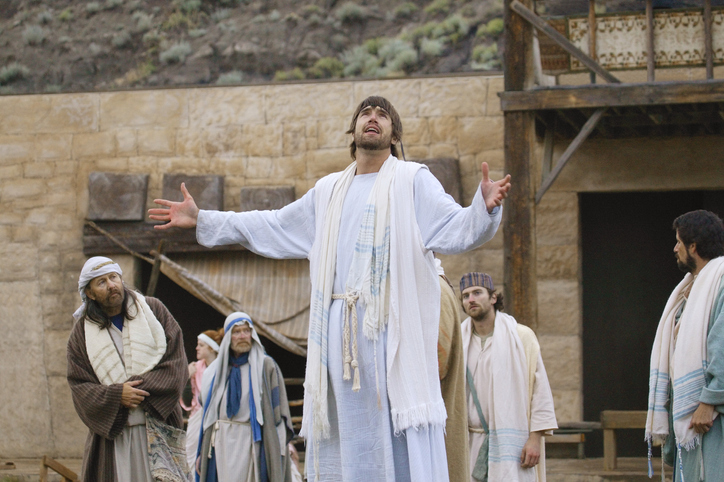Sabbath School Lesson for August 31-September 6, 2024
Overview of Lesson 10, The Last Days
Memory Text: ” ‘Then they will see the Son of Man coming in the clouds with great power and glory. And then He will send His angels, and gather His elect from the four winds, from the farthest part of the earth to the farthest part of heaven.’ ” Mark 13:26, 27 NKJV
Before moving on to the thirteenth chapter of Mark, we must not overlook a story at the end of chapter 12. Jesus had already cleansed the temple of cheaters, unruly moneychangers, but He also noticed there a poor widow who gave all she had to the Lord without reservation–unlike the Pharisees, who gave their bountiful offerings with showy pomp and self-glory. See Mark 12:38-44.
As the disciples later moved through the temple, they complimented the massive, beautiful structure. But Jesus saw it in light of its future destruction, and could only respond that someday there would not be one stone left upon another.
Later, on the Mount of Olives, a few disciples came to inquire more about Jesus’ disturbing prediction, and received prophecies that would reach far into the future. As His disciples, then and now, it helps us to know the signs to look for, and ways we can prepare for the coming crisis at the end of this world’s history.
These are the topics in this week’s study:
- Sunday: Two Little Coins in the Offering–All who humbly give resources to God (whether they are managed properly or not) will be blessed for their sacrificial giving.
- Monday: Not One Stone on Another–The disciples were startled by Jesus’ dire prediction about the temple’s destruction.
- Tuesday: The Abomination of Desolation–How was this first prediction fulfilled?
- Wednesday: The Great Tribulation–What did Jesus mean by this prophecy, and when would it occur?
- Thursday: The Coming of the Son of Man–What signs can we look for before the Lord returns?
Sunday: Two Little Coins in the Offering (Mark 12:38-44)
It’s obvious from Mark 12:38-40 that the scribes and church officials in charge of the temple were not using the funds for its operation very well. Besides elaborate displays of their own giving, they kept the best gifts for their own comfort. They lavishly remodeled and furnished the temple, but often left widows and the poor without housing.
Jesus, however, forever immortalized the simple gift of a poor widow (Mark 12:41-44). He noticed her paltry two mites, which was about a day’s wages. Although nothing seemed to compare with the lavish gifts of others, Jesus knew that her monetary sacrifice was all she had. He rightfully pointed out to the disciples that her gift was the greatest one of all. She gave out of her poverty, while so many others had given out of their abundance.
The example of her faithful act of giving was used by Jesus to set the stage for the prophecies He then shared about the temple’s destruction. We all need the faith and sacrificial devotion of that poor widow, in order to make it through the critical days ahead.
Bible Verses:
Mark 12:38-40
- Why were the actions of the scribes so displeasing to God?
- While claiming to obey God, what were they missing?
Mark 12:41-44
- What made the widow’s gift so much greater than the others?
- How has the value of her gift been multiplied by Jesus’ words of recognition?
Monday: Not One Stone on Another (Mark 13:1-13)
It’s hard to imagine the splendor and size of the temple in Jerusalem when Jesus was there. Historians have described the Royal Portico on the south side of the structure as having 162 pillars. Each of these pillars was so large that it took three men, holding out their arms and clasping hands, to reach around one of them.
No wonder the disciples were astonished when Jesus predicted sadly that someday not one stone of the temple would be left on another. Four of the disciples who had been fishermen (James, John, Peter, and Andrew) were so disturbed by His comment that, when they later rested on the Mount of Olives, they asked Jesus when that unthinkable prophecy would come to pass.
Jesus then provided them many signs to watch for as the time of fulfillment drew near (Mark 13:1-13). The chaotic days would involve persecution, but they were told that the Holy Spirit would empower them to endure to the end.
These prophecies were so significant that both the other synoptic Gospels include them. See Matthew 24 and Luke 21.
Bible Verses to Explore:
Mark 13:1-2
- Why was Jesus not as excited about the splendor of the temple facility as His disciples were?
Mark 13:3-13
- Why were they not to worry when they would be questioned and persecuted?
Tuesday: The Abomination of Desolation (Mark 13:14-18)
Just as it’s been understood in Matthew 24, Jesus’ prophecies about coming destruction covered two big events. The first one involved “the abomination of desolation” as it’s called in Daniel (Daniel 9:26, 27 and 11:31). Jesus even indicated to His disciples that the abomination was spoken of in Daniel’s prophecies (Mark 13:14).
This horrific, desecrating event occurred in 70 A.D., when Rome attacked Jerusalem and destroyed the temple and most of the city. Daniel 9:26 spoke of a prince who would come to destroy the city and the sanctuary. That prince, thought by some to be the Roman general Titus, desecrated the glorious temple mount, planting pagan standards in holy places during his siege of Jerusalem.
Luke 21:20-24 also described Jerusalem’s destruction. They were told that “when you see Jerusalem surrounded by armies, then know that its destruction is near” (Luke 21:20). According to historians, it happened just as foretold a few decades after Christ’s death. Christians were able to escape the carnage by following the Savior’s directions to flee to the mountains.
Bible Verses to Explore:
Mark 13:14-18, Daniel 9:26, 27, and Daniel 11:31
- Why would Jerusalem’s treatment of the Anointed One, the Messiah, lead to its destruction as described in these verses?
- How does the fulfillment of this prophecy help us trust other predictions in the Bible?
Wednesday: The Great Tribulation (Mark 13:19-23)
After the abomination of desolation, the destruction of Jerusalem, Jesus spoke about a great tribulation time that would come later. Daniel also threw light on a troubling time of persecution. Chapters 7 and 8 of Daniel described the massive persecution of a little horn power, which we have seen fulfilled during the papal rule of nations, lasting from 538 to 1798 A.D., or prophetically for 1,260 years.
But, Revelation 13 indicated that this blasphemous, persecuting power would come back. And then, at the very end of time, there will be a persecution that Jesus describes as like no other before it since the creation of our planet.
We will see, at the very end, many false christs and prophets, performing signs and wonders, and deceiving many. But Jesus encourages us to hold fast to our faith, remembering that this time of intense persecution will be shortened for the sake of His people.
Bible Verses to Explore:
Mark 13:19-23
- Why would it be wrong to look for Christ to appear in just one place on earth?
- What other kinds of signs and wonders might the devil perform, in order to mimic Christ?
- How does using the historicist interpretation of prophecy, seeing things fulfilled partially in history, rather than interpreting all prophecy as fulfilled in the past (preterist) or the future (futurist), help build our faith in the soon-coming Lord?
Thursday: The Coming of the Son of Man (Mark 13:24-32)
The rest of Mark 13 speaks of the time before Jesus comes again to this earth “with power and great glory” (Mark 13:26)–in other words, at the Second Coming of Jesus.
Jesus has revealed to us that there would be signs in the sun (it will be darkened), the moon (it will not give its light), and the stars (they will fall). “The powers in the heavens will be shaken” (Mark 13:25). There will be no question that a momentous time of rescue for God’s people will soon occur.
His angels will then gather together His elect (Mark 13:27). This grand resurrection event is also described beautifully in 1 Thessalonians 4:13-18 and in 1 Corinthians 15:51-58. It will be visible and audible–an actual, personal experience that the followers of God, along with the holy angels, will welcome with overwhelming joy.
Bible Verses to Explore:
Mark 13:7-8, 24-32 and Luke 21:25-28
- How are the signs in the heavens helpful as we anticipate our day of redemption?
- What additional signs on earth are we given?
Friday: Final Thoughts
There are various conclusions and beliefs about last day events, or eschatology, in the Bible. No doubt, it’s confusing when we see more than one event described in a single prophecy. But just as there was a purpose in having dual applications in the parables Jesus told (so people would get more than one lesson from them), there are reasons why some prophecies cover more than one event.
All the predictions Jesus made in Mark 13 were yet in the future when He gave them. But the temple’s destruction (the one the disciples were most concerned about) would happen just a few decades later, in “their generation”. The directions Jesus gave about when to leave the city and flee to the mountains certainly proved critical in surviving the horrific slaughter that Rome inflicted on Jerusalem in 70 A.D.
Therefore, being able to watch and prepare for the fulfillment of prophecy is a solid, practical reason for God giving it to us. But just as important, as we see predictions coming to pass throughout history, our faith is strengthened, enabling us to endure to the end. Our hearts are comforted in knowing that God is in control.
He’s in control of the past, the present, and the future. That’s why He’s called the great I AM. He is always there for us, as a lighted beacon of hope in a sea of darkness. We can rest assured that His truth and love will triumph.
Next Week: Taken and Tried
To read the Sabbath School Lesson Quarterly and see more resources for its study, go to







